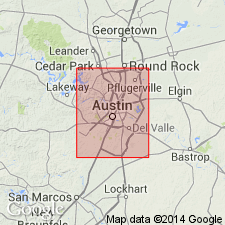
- Usage in publication:
-
- Pilot Knob tuff
- Modifications:
-
- First used
- Dominant lithology:
-
- Tuff
- Ash
- AAPG geologic province:
-
- Ouachita folded belt
Summary:
First used in discussion of Upper Cretaceous volcanics in vicinity of Pilot Knob, a hill 6-8 mi south-southeast of the State Capitol, Austin, Travis Co, TX in Ouachita tectonic belt province. Consists of igneous material, extruded in the form of ash and cinders, that locally accumulated to considerable thickness. The prominence at Pilot Knob is a hill of olivine basalt with a nepheline groundmass; the surrounding circular valley is weathered into the less resistant ash. Also called Pilot Knob ash and tuff at Pilot Knob. Is bedded dark-green bentonitic tuff on Turnersville Creek where the beds are associated with the GRYPHAEA AUCELLA beds in middle part of Dessau formation (new). Is locally cross bedded, channeled, and contains fossils. Columnar sections and correlations (pl. 16). Age is Late Cretaceous.
Source: GNU records (USGS DDS-6; Denver GNULEX).

- Usage in publication:
-
- Pilot Knob tuff
- Modifications:
-
- Overview
- AAPG geologic province:
-
- Ouachita folded belt
Summary:
Is used as map unit [informal] in vicinity of Pilot Knob, a hill west of the community of Pilot Knob, Travis Co, TX in Ouachita tectonic belt province. Is a tan to green-brown, altered, nontronitic pyroclastic material. Much of the original tuff material has been altered to clay. Thickness varies from a few in to about 500 ft, with the greatest accumulation occurring in the low area around Pilot Knob. Unit interfingers with Dessau Formation and locally contains thin calcite beds and limestone fragments. [Stratigraphic relations are inconsistently presented. Geologic map explanation (pl. VII) lists the tuff below Austin Group and above Pilot Knob basalt (new, informal). However, Table 7 shows the tuff as a formation in the upper part of Austin Group, above McKown Formation and below Pilot Knob basalt.] Age is Late Cretaceous.
Source: GNU records (USGS DDS-6; Denver GNULEX).
For more information, please contact Nancy Stamm, Geologic Names Committee Secretary.
Asterisk (*) indicates published by U.S. Geological Survey authors.
"No current usage" (†) implies that a name has been abandoned or has fallen into disuse. Former usage and, if known, replacement name given in parentheses ( ).
Slash (/) indicates name conflicts with nomenclatural guidelines (CSN, 1933; ACSN, 1961, 1970; NACSN, 1983, 2005, 2021). May be explained within brackets ([ ]).

